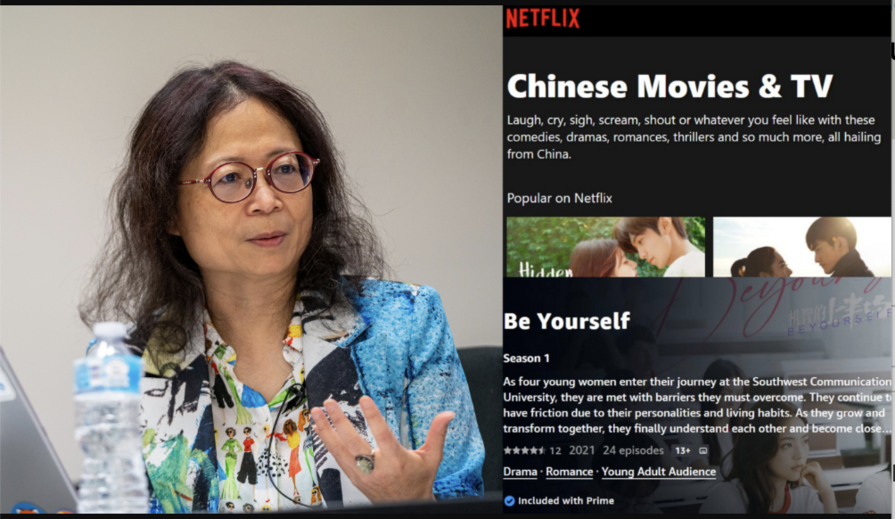
Talking Points
September 5 - 14, 2011
Chinese firms are buying land and other assets in the United States. Last week one such company, SZ Prosperity, paid $5.65 million to buy a successful mini-mall in Temecula, a city of 58,000 located about 85 miles (136 kilometers) from Los Angeles. Already this year, Rhodium, a consultancy, estimates Chinese firms have invested $3.3 billion in the U.S. According to the U.S. Bureau of Economic Analysis, Chinese firms employed 4,300 people in the U.S. in 2009. Even so, it will be some time before Chinese investments match the impact American investments in China have had. General Motors, alone, has ten joint ventures in China and employs more than 35,000 people there.
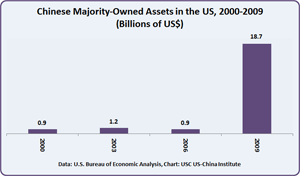 | 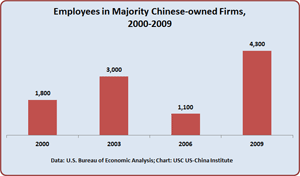 |
These investments in energy, information technology, auto parts, and other industries pale in comparison to the $1.2 trillion China has invested in various forms of U.S. government debt. Here, too, there has been a rapid increase in China’s holdings since 2000.
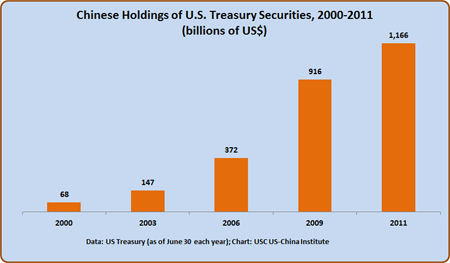
As a result of China’s rapid economic rise, some question the utility of U.S. government assistance to China. Senators Tom Coburn (R-Oklahoma), Jim Inhofe (R-Oklahoma), and Jim Webb (D-Virginia) are among those raising questions about spending American tax dollars in this way.
Coburn argues sending money to China and borrowing money from China creates a co-dependency that isn’t healthy for either side. Webb and Inhofe argue that China could afford to help itself and that the U.S. should aid more needy countries or simply keep the money here. Inhofe is particularly incensed about grants to China to address air pollution. He said, "the Obama EPA has been spending millions of taxpayer dollars in places like China - a country we already owe 1.2 trillion - to promote its liberal climate change agenda... This is truly the outrage of the year." The Traditional Values Coalition launched a campaign to draw attention to the issue.
Most of the programs under discussion have been in place for many years. They are receiving attention now because of the ongoing budget battles and because the 2012 campaign has already begun. China’s rise and economic anxiety across America have politicians bringing China and American ties to China ever more frequently into political debates. While the size of these programs is small compared to the total U.S. budget, foreign aid has never been popular. U.S. budget woes have exacerbated those doubts. In January, 59% of those surveyed told the Gallup Organization they favored cutting foreign aid. One reason so many favor such cuts is most Americans overestimate the amount of money going to foreign aid. A University of Maryland survey earlier this year found that half of those polled thought that more than 15% of the U.S. federal budget went to foreign aid. In fact, about one-tenth that amount, between 1.3% and 1.6%, went to foreign aid the past three years.
The charts below show total federal spending and the top recipients of the portion of the budget that goes to foreign aid. 63% of the federal budget goes to security, pensions, and healthcare. The top recipients of foreign assistance include allies in troubled regions, countries facing humanitarian crises, and states immersed in narco-conflicts. Russia, America’s cold war rival and the ninth-largest holder of U.S. government debt, received $332 million in assistance in 2009, more than 10-times that allocated China.
 | 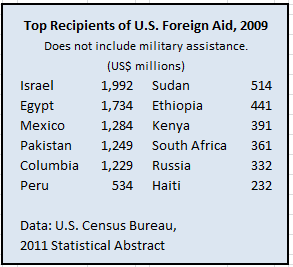 |
U.S. Aid to China
The chart below reflects most but not all U.S. government assistance to China. It shows assistance provided through the U.S. State Department and the U.S. Agency for International Development. Those two agencies use seven categories for foreign assistance. Over the past five years, awards to China have been made in five categories. (Please note that the 2011 figures are proposed and have not yet been approved.) The categories below are listed in order of total allocation/proposed allocation 2007-2011.
Health
For 2007-2010 $30 million was allocated to health-related projects. For fiscal year 2011, $7 million has been proposed. Among the targeted areas are HIV/AIDS, tuberculosis, mosquito-borne
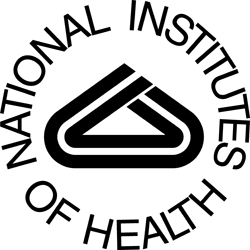 |
illnesses, and reproductive health. These are the grants that most upset the Traditional Values Coalition. (Click here for a discussion of those claims and a list of NIH grants to Chinese researchers.)
On a per capita basis, China is a relatively poor country, but thanks in part to American assistance it has developed what noted epidemiologist Roger Detels (UCLA) describes as “the most comprehensive program [to control HIV/AIDS] in Asia.” He credits the government with initiating and evaluating a range of programs to address IV drug use and sexual transmission of the disease. U.S. assistance, including National Institutes of Health and USAID grants, has helped make implementation and evaluation of these programs possible. Detels credits the government with working with non-governmental organizations to reach at-risk populations such as men having sex with men. Wan Yanhai, a well-known former Ministry of Health official turned organizer-activitist, however, is less impressed. Wan feels that American assistance (including that provided by the Centers for Disease Control and the Gates Foundation) tends to remain in state hands rather than going to organizations such as his to provide confidential testing, public health education, develop secondary school curriculum on sex and HIV/AIDS, and other services.
China was slow to address the HIV/AIDS epidemic and the government suppressed word of a plasma donation tragedy that devastated entire villages. In the past decade, however, there has been a systematic effort featuring prominent individuals such as Premier Wen Jiabao, basketball star Yao Ming, and actress Zhang Ziyi to promote understanding of the disease and to fight prejudice against those who suffer from it and those who work to help them.
HIV/AIDS is a growing problem in China and elsewhere. Tuberculosis, malaria, and schistosomiasis are chronic challenges that NIH-funded research is also helping to address. About 0.03% of the total annual NIH research budget is being allocated to these programs.
Environment
Air pollution in China is so bad that the World Bank in 2007 estimated it lead to hundreds of thousands of premature deaths each year. Water pollution was estimated to take another 90,000 lives each year. Since then, China’s rapid industrial growth and embrace of the automobile has made it the number one consumer of energy and producer of greenhouse gases. Since 2007, the U.S. government has provided $22 million in grants to address these problems. Just $1 million in awards have been proposed for fiscal year 2011.
U.S.-Chinese cooperation on environmental issues began in the 1990s and was formalized with agreements forged during the George W. Bush administration. The U.S. and China together account for about 40% of the world’s greenhouse gases. The U.S. Environmental Protection Agency has been eager to help China develop cleaner burning coal plants and to move to alternative fuels such as methane. In 2009, 27% of EPA “methane to markets” spending went to projects in China (many of these projects were carried out with the EPA or other American entity). Click here to see a list of such projects.
USAID environmental projects in China include work on sustainable building designs, carbon trading, imported solid waste management, and biodiversity. These often involve U.S. researchers, such as those at the Western Kentucky University China Environmental Health Project. Many of these efforts have a civil society and governance component as well. For example, projects include efforts to increase local involvement in water management and to support an non-governmental organization’s work on environmental health litigation.
Democracy, Human Rights, and Governance
For many years, Congress has pushed the executive branch to promote human rights and greater democracy in China. On occasion, Congress adopted specific legislation for National Endowment for Democracy programs in China. At other times, it has responded to events in China, such as the civil unrest in Tibet in 2008 with funding to promote the maintenance of cultural traditions.
Most of these programs have been administered by the State Department’s Bureau of Democracy, Human Rights, and Labor. Even though this has been a relatively large effort for the U.S. government,
the European Union has been more active in this area than the U.S. government. Ford Foundation programs have been larger than those sponsored by the U.S. government. Ford awarded $54 million in grants in China, 2006-2008. In the period 2007-2010, the U.S. government allocated $19 million to these programs. It has proposed allocating just $1 million for this in the next fiscal year.
Most of the U.S. aid goes to American NGOs (e.g., the American Bar Association) and universities (e.g., Temple University) which subsequently carry out training and other projects within China. In recent years, foreign NGOs and Chinese NGOs receiving foreign funding have come under stricter control from the Chinese state. Some Chinese NGO leaders have been arrested and others, such as Wan Yanhai (mentioned above), feared detention or arrest and left China.
Crackdowns such as these cause some observers of these programs to complain that they have little effect. Others argue that repression makes such programs all the more essential. They argue that legal exchanges encourage those in China who seek continued reform, greater openness, and popular participation in decision-making.
Economic Development
Though it came in for criticism as an “aid” program, the assistance the U.S. Trade Development Agency provides in China is mostly funneled through American companies and organizations and is intended to create markets for American exporters. Senators Web and Inhofe feel that there’s already plenty of US-China trade and that the USTDA should direct its energies to finding new
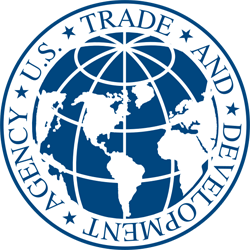 |
markets in emerging economies.
For the current year, USTDA made grants totaling $6.2 million, about 12% of the agency’s total. Recipients included the American Chamber of Commerce in China and the Federal Aviation Administration ($728,741) to help train Chinese personnel to improve safety and security. The Chamber and FAA combined to get a second grant for $710,652 for work on a second airport plan for Beijing. Other large grants went to GE Energy for a power plant feasibility study ($832,877) and to the National Electrical Manufacturers Association to work with Chinese firms in workshops and conferences to establish and promote manufacturing standards ($499,803). A Washington firm that specializes in “reverse trade missions” is receiving $542,302 to bring Chinese clean energy buyers to the U.S.
Figures for China are not broken out, but the USTDA claims to have generated $47 in U.S. exports for every dollar it put into 2009 activities.
Peace Corps
The Peace Corps was able to enter China in 1993 and 669 volunteers have since served in teachers’ colleges in China’s interior. They work in poorer areas such rural Sichuan and Guizhou, where per capita incomes are low. They teach English and many pursue secondary projects such as working with handicapped orphans. At present, $2.9 million is spent to support the 138 volunteers in China.
 |
That amounts to $21,000 a volunteer. In return the U.S. has a typically bright and energetic citizen working closely with students, strengthening their students’ ability to use English to understand others and to express themselves. They also interact with townspeople in areas where foreigners are seldom seen, even today. Those volunteers also have a terrific opportunity to learn Chinese, develop close ties with Chinese, and begin to forge a deep understanding of the country.
Many volunteers wind up pursuing some sort of career that affords them the chance to utilize their experience in China. A few Peace Corps volunteers have become influential writers: Peter Hessler, formerly of the New Yorker and author of three books; Rob Schmitz of public radio’s Marketplace; Craig Simons of Cox Newspapers; Mike Meyer, author of The Last Days of Old Beijing; Ramy Inocencio of CBS Mobile News; and Jake Hooker, winner of a Pulitzer Prize for his New York Times reporting on toxic imports from China. Each of these individuals, plus those in education and other fields, had an impact on how Americans are perceived in China and each has done much to enrich American understanding of China.
Rather than shutting the Peace Corps operation in China down, the Obama administration wants to dramatically expand it to $4.7 million. It seems like a public diplomacy and training bargain.
Still, money is tight. Hard decisions need to be made. It is prudent, though, to engage in an informed discussion of these aspects of the US-China relationship.
*****
We hope you’re making plans to join us at USC later this month for our programs on Chinese investment in Latin America and on Why Taiwan Matters. We also hope you’ll mark your calendar for November 9 when Ezra Vogel, one of the field’s most distinguished scholars, visits to discuss his new book on Deng Xiaoping and the Transformation of China.
The USC term is only two weeks old, but we encourage students and faculty to begin planning for next summer and beyond. Our website has information about a range of summer study abroad options as well as information for graduate students and faculty about this year’s research grant opportunities.
Thanks for reading Talking Points. Please pass it along to others and encourage them to subscribe. We love hearing from you. Please write to us at uschina@usc.edu and please consider supporting us with a tax deductible contribution.
Best wishes,
The USC US-China Institute
Subscribe at http://china.usc.edu/subscribe.aspx
Talking Points archive: http://china.usc.edu/resources60.aspx
Donate at https://giveto.usc.edu/pledge.asp
Events
USC | California | North America | Exhibitions
09/08/2011: China Taiwan Study Abroad Info Session
University of Southern California
Campus Center 232, Los Angeles, CA 90089
Cost: Free
Time: 10:00AM - 2:00PM
The USC Office of Overseas Studies is hosting an informational session on study abroad programs in China and Taiwan.
09/16/2011: Chinese Investments in Latin America
USC Campus , Los Angeles, CA 90089
Cost: $35 registration fee
Please join us for a one-day conference on China's economic involvement in Latin America.
09/27/2011: Why Taiwan Matters: Small Island, Global Powerhouse
Davidson Conference Center, Club Room
University of Southern California, Los Angeles, CA 90089
Cost: Free
Time: 4:00PM - 5:30PM
A talk by Shelley Riggers discussing her book about global impacts that Taiwan has on the world.10/13/2011: USC Global Conference Hong Kong 2011: Global Challenges and Enhancing Opportunities
JW Marriott Hotel Hong Kong
Pacific Place, 88 Queensway, Hong Kong, China
The two day conference will feature New York Times and Pulitzer Prize winning author Thomas L. Friedman.
10/21/2011 - 10/22/2011: Media and Culture in Contemporary China
UCLA and USC Campuses, Los Angeles, CA
A two-day conference featuring Chinese Producer Zhang Jizhong.
09/07/2011: Developmental Fairy Tales: Evolutionary Thinking and Modern Chinese Culture
University of California, Berkeley
Institute of East Asian Studies, 2223 Fulton St, 6th Floor , Berkeley, CA
Cost: Free
Time: 4:00PM - 5:30PM
UC Berkeley's Andrew Jones will speak about developmental fairy tales in China.
09/07/2011: Penjing: From its Roots to the Present Day
The Huntington Library
1151 Oxford Road, San Marino, CA 91108
Cost: Free and open to the public
Time: 7:30PM - 8:30PM
Part of the Chinese and Japanese Garden Lecture Series at The Huntington Library.
09/09/2011: Whither China? Revisiting the Dangers of Nationalism and Democratization
UC Berkeley
IEAS conference room, sixth floor
2223 Fulton Street, Berkeley, CA 94720
Time: 4:00PM - 6:00PM
The Institute of East Asian Studies will host Peter Lorentzen and Jessica Chen Weiss to discuss China, nationalism, and democracy.
09/14/2011: Meet Albert Lew
Chinese American Museum
425 N. Los Angeles Street, Los Angeles, CA 90012
Time: 10:00AM - 3:00PM
Engage in a lively chat with Albert Lew as he relives his childhood days in the original Sun Wing Wo Store.
09/07/2011: One Hundred Years of Historical Changes in China: Sino-Soviet Relations
Bellevue City Hall
450 110th Ave. NE (Northeast Fourth Street and 110th Avenue Northeast) , Bellevue, WA 98009
Time: 5:00PM - 7:00PM
The East Asia Center at the University of Washington presents a talk by Zhihua Shen on the Sino-Soviet alliance.
09/07/2011: Assignment: China
Asia Society and Museum
725 Park Avenue(at 70th Street), New York, NY 10021
Cost: Free admission, but registration required.
Time: 6:30PM - 8:00PM
Asia Society presents the screening of ASSIGNMENT: CHINA, one episode of a multi-part documentary series on the history of American correspondents in China dating back to the 1940s.
09/08/2011: Deals / IPOs / Returns: China Style
NASDAQ Market Site, New York
Cost: $80
Time: 4:00PM - 8:00PM
Silicon Asia hosts a conference.
09/14/2011: Reading the Popular Chinese Print: A Lecture by Ellen Johnston Laing
The University of Michigan Museum of Art
Helmut Stern Auditorium, 525 South State Street, Ann Arbor, Michigan 48109-1354
Time: 5:00PM - 6:30PM
Ellen Johnston Laing will draw on examples from Chinese woodblock prints to take a look at the subjects depicted in popular prints, their visual and artistic characteristics, their physical contexts, and the traditional ceremonies associated with them.
ends 08/31/2011: Long Live and Prosper: Auspicious Motifs in East Asian Art
Tateuchi Galleries
1400 East Prospect Street Volunteer Park , Seattle, WA 98112
Paintings, lacquerware, jades, textiles, and porcelain from China, Japan, and Korea will be on display at the Seattle Asian Art Museum.
ends 09/03/2011: Finding Chinatown
Craig Krull Gallery at Bergamot Station
2525 Michigan Avenue, Building B-3 , Santa Monica, CA 90404
Sara Jane Boyers' decade long project photographing in the Chinatowns of the US & Canada is having its first solo exhibition.
ends 09/05/2011: Chinese Puzzles: Games for the Hands and Mind
The Museum of Chinese in America
215 Centre Street, New York, NY 10013
The Museum of Chinese in America (MOCA) located in New York hosts an exhibition about Chinese puzzles.
ends 09/05/2011: Porcelain for the Emperor: Chinese Ceramics of the Kangxi Reign (1662–1722)
Philadelphia Museum of Art
Gallery 226, second floor, 26th Street and the Benjamin Franklin Parkway, Philadelphia, PA 19130
Cost: Free for members, Adults: $16, Seniors (ages 65 & over): $14, Students (with valid ID): $12, Children ages 13–18: $12, ages 12 & under: Free
Philadelphia Museum of Art hosts an exhibition that showcases the extraordinary technical and aesthetic achievements of the Kangxi-era potters.
ends 09/07/2011: The Dalai Lama and His People
Tibet House
22 West 15th Street, New York, New York 10011
The Tibet House in New York City presents an exhibition showcasing Don Farber's photographs of His Holiness the Dalai Lama across a 30-year span.
05/21/2011 - 09/11/2011: Tradition Transformed: Tibetan Artists Respond
The Crow Collection of Asian Art
2010 Flora Street , Dallas, TX 75201
The Crow Collection presents an exhibition of artists' responses to transforming traditions in Tibet.
Please invite others to subscribe to USCI’s free email newsletter for regular updates on events and programs. We will not share names or email addresses with any other entity. Click here to sign up. We provide information about China-related events as a community service. If you would like your event considered for inclusion in the USCI calendar, please click here to submit event details.
You can support USCI by making a tax-deductible donation at http://www.usc.edu/giving/
USC U.S. – China Institute
3535 S. Figueroa St.
FIG 202
Los Angeles, CA 90089-1262
Tel: 213-821-4382
Fax: 213-821-2382
Email: uschina@usc.edu
Website: http://china.usc.edu
You have received this e-mail because you have subscribed to receive updates from USCI. If you feel this message has reached you in error or you no longer wish to receive our updates, please click, unsubscribe, and enter "Remove" in the subject line.








